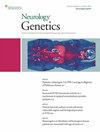Adult Phenotype of SYNGAP1-DEE.
IF 3
3区 医学
Q2 CLINICAL NEUROLOGY
Neurology-Genetics
Pub Date : 2023-11-17
eCollection Date: 2023-12-01
DOI:10.1212/NXG.0000000000200105
引用次数: 0
Abstract
Background and Objectives SYNGAP1 variants are associated with rare developmental and epileptic encephalopathies (DEEs). Although SYNGAP1-related childhood phenotypes are well characterized, the adult phenotype remains ill-defined. We sought to investigate phenotypes and outcomes in adults with SYNGAP1 variants and epilepsy. Methods Patients 18 years or older with DEE carrying likely pathogenic and pathogenic (LP/P) SYNGAP1 variants were recruited through physicians' practices and patient organization groups. We used standardized questionnaires to evaluate current seizures, medication use, sleep, gastrointestinal symptoms, pain response, gait, social communication disorder and adaptive skills of patients. We also assessed caregiver burden. Results Fourteen unrelated adult patients (median: 21 years, range: 18–65 years) with SYNGAP1-DEE were identified, 11 with novel and 3 with known LP/P SYNGAP1 de novo variants. One patient with a partial exon 3 deletion had greater daily living skills and social skills than others with single-nucleotide variants. Ten of 14 (71%) patients had drug-resistant seizures, treated with a median of 2 antiseizure medications. All patients (100%) had abnormal pain processing. Sleep disturbances, social communication disorders, and aggressive/self-injurious behaviors were each reported in 86% of patients. Only half of adults could walk with minimal or no assistance. Toileting was normal in 29%, and 71% had constipation. No adult patients could read or understand verbal material at a sixth-grade level or higher. Aggressive/self-injurious behaviors were leading cause of caregiver burden. The oldest patient was aged 65 years; although nonambulant, she had walked independently when younger. Discussion Seventy-one percent of patients with SYNGAP1-DEEs continue to have seizures when adults. Nonseizure comorbidities, especially aggression and self-injurious behaviors, are major management challenges in adults with SYNGAP1-DEE. Only 50% of adults can ambulate with minimal or no assistance. Almost all adult patients depend on caregivers for many activities of daily living. Prompt diagnostic genetic testing of adults with DEE can inform clinical care and guide outcomes of precision therapies.SYNGAP1-DEE的成体表型。
背景和目的:SYNGAP1变异与罕见的发育性和癫痫性脑病(dei)有关。尽管syngap1相关的儿童期表型已被很好地表征,但成年期表型仍不明确。我们试图研究患有SYNGAP1变异和癫痫的成人的表型和结果。方法:通过医师实践和患者组织小组招募18岁及以上携带可能致病性和致病性(LP/P) SYNGAP1变异的DEE患者。我们采用标准化问卷评估患者的当前癫痫发作、药物使用、睡眠、胃肠道症状、疼痛反应、步态、社交沟通障碍和适应技能。我们还评估了照顾者的负担。结果:确定了14例与SYNGAP1- dee无关的成人患者(中位:21岁,范围:18-65岁),其中11例为新型,3例为已知LP/P SYNGAP1从头变异体。一名部分外显子3缺失的患者比其他单核苷酸变异的患者有更好的日常生活能力和社交能力。14例患者中有10例(71%)有耐药癫痫发作,平均使用2种抗癫痫药物治疗。所有患者(100%)疼痛处理异常。86%的患者报告有睡眠障碍、社交障碍和攻击/自残行为。只有一半的成年人可以在很少或没有帮助的情况下行走。29%的人排便正常,71%的人便秘。没有成年患者能够阅读或理解六年级或更高水平的口头材料。攻击性/自残行为是造成照顾者负担的主要原因。年龄最大的患者65岁;虽然不能走动,但她年轻时就能独立行走。讨论:71%的syngap1 - dee患者成年后仍有癫痫发作。非癫痫合并症,特别是攻击和自残行为,是SYNGAP1-DEE成人患者的主要管理挑战。只有50%的成年人可以在很少或没有帮助的情况下行走。几乎所有成年患者的许多日常生活活动都依赖于护理人员。成人DEE的快速诊断基因检测可以为临床护理提供信息,并指导精确治疗的结果。
本文章由计算机程序翻译,如有差异,请以英文原文为准。
求助全文
约1分钟内获得全文
求助全文
来源期刊

Neurology-Genetics
Medicine-Neurology (clinical)
CiteScore
6.30
自引率
3.20%
发文量
107
审稿时长
15 weeks
期刊介绍:
Neurology: Genetics is an online open access journal publishing peer-reviewed reports in the field of neurogenetics. Original articles in all areas of neurogenetics will be published including rare and common genetic variation, genotype-phenotype correlations, outlier phenotypes as a result of mutations in known disease-genes, and genetic variations with a putative link to diseases. This will include studies reporting on genetic disease risk and pharmacogenomics. In addition, Neurology: Genetics will publish results of gene-based clinical trials (viral, ASO, etc.). Genetically engineered model systems are not a primary focus of Neurology: Genetics, but studies using model systems for treatment trials are welcome, including well-powered studies reporting negative results.
 求助内容:
求助内容: 应助结果提醒方式:
应助结果提醒方式:


